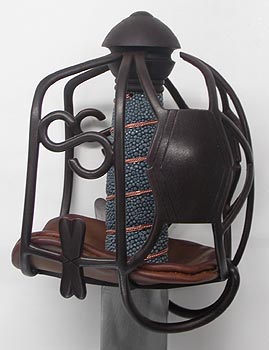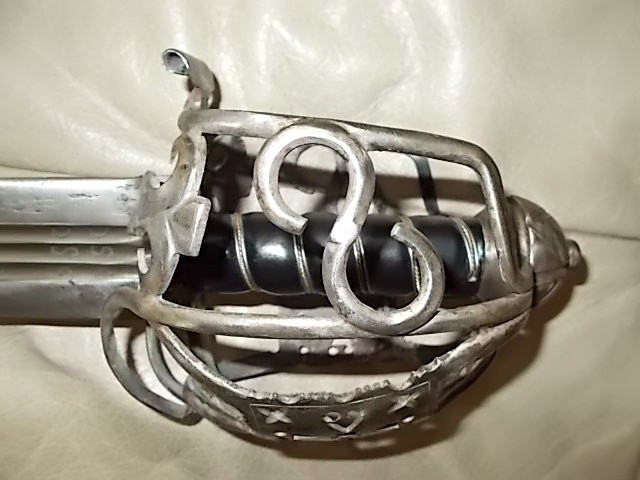I've been doing a bit of reading up on Early Modern Scottish armies, and I was surprised to find that only references to Scottish swords in the 16th century were big two-handers. This struck me as odd since it seems like just about everyone else was adopting complex single handed swords around about 1500, and by 1540 or so, the English seem to have been using basket-hilted broadswords similar to the ones the Scots would eventually become famous for. Is this mostly due to Scotland being a bit of a military backwater, or am I just looking in the wrong places for examples of early Scottish side-sword/broadsword use?
On a somewhat related note, can anyone recommend a decent quality reproduction Highland basket-hilt broadsword? I've been tempted by this one, but I know nothing about the maker, and I'm very leery of buying swords from unknown entities. https://www.ebay.com/itm/The-Scottish-Basket-Hilt-Broadsword-Scabbard-with-Hand-Made-EN45-Blade/282929639903?_trkparms=aid%3D222007%26algo%3DSIM.MBE%26ao%3D2%26asc%3D50998%26meid%3D276d7b5619134b9e9d0efd705be59c58%26pid%3D100623%26rk%3D1%26rkt%3D6%26sd%3D272657895445%26itm%3D282929639903&_trksid=p2047675.c100623.m-1
Hello Dashiell..
I am not sure what reference you are looking at but if it refers to "claymores" it is not necessarily talking about two handed swords. There is no evidence that the two hander was referred to in that manner until the late 18th century. I am probably going to get an argument about that.
Scottish basket hilts first appeared some time in the mid to late 16th century. The early swords had less coverage of the hand because the guards were fabricated from round stock as opposed to the flat stock of later eras. By the mid-17th century the bars had begun to be flattened and there was engraving and other decoration applied to the guards. From earliest times the blades themselves were imported to Scotland from Germany, France, Spain and other European countries. The hilts were what were made in Scotland.
English sword makers also embraced the basket hilt and many English-made swords are, at a glance, indistinguishable from the Scottish product. That continued to be the case well into the 18th century.
I would suggest obtaining a copy of Harvey J. S. Withers' book on Scottish Swords and perhaps John Wallace's small but very informative book on the same subject.
As far as good replicas, if you are looking for factory produced as opposed to custom, Hanwei makes a pretty good Glasgow style basket hilt. Unfortunately they make the basket of stainless steel, the sword is heavy, but not excessively so, and the basket too large but that is S.O.P. with mass produced stuff. "Semi -Custom makers," like Armour Class, do a much better job of recreating the originals, as far as appearance and weight go. The one you linked is a poor example of an attempt at an S Hilt. I noted the vendor also sells the MR Eglin sword, which looks nice but has a HUGE basket. I have attached a photo of my Armour Class S Hilt for comparison as well as a photo of my Donnie Shearer made S Hilt.
Scotland was not necessarily a backwater militarily, but it was always the "poor relation" on the island of Britain. For that reason it was slow to make significant changes in its weapons, along with many other things. One example was the fact that Scottish gun makers clung to the snaphaunce lock, long after it was displaced by the flintlock in most of Europe.
Good luck in your search. There are some decent swords out there but be prepared to pay more than $159 if you are looking for quality and authenticity.
 Attachment: 17.59 KB
Attachment: 17.59 KB

 Attachment: 126.74 KB
Attachment: 126.74 KB

I am not sure what reference you are looking at but if it refers to "claymores" it is not necessarily talking about two handed swords. There is no evidence that the two hander was referred to in that manner until the late 18th century. I am probably going to get an argument about that.
Scottish basket hilts first appeared some time in the mid to late 16th century. The early swords had less coverage of the hand because the guards were fabricated from round stock as opposed to the flat stock of later eras. By the mid-17th century the bars had begun to be flattened and there was engraving and other decoration applied to the guards. From earliest times the blades themselves were imported to Scotland from Germany, France, Spain and other European countries. The hilts were what were made in Scotland.
English sword makers also embraced the basket hilt and many English-made swords are, at a glance, indistinguishable from the Scottish product. That continued to be the case well into the 18th century.
I would suggest obtaining a copy of Harvey J. S. Withers' book on Scottish Swords and perhaps John Wallace's small but very informative book on the same subject.
As far as good replicas, if you are looking for factory produced as opposed to custom, Hanwei makes a pretty good Glasgow style basket hilt. Unfortunately they make the basket of stainless steel, the sword is heavy, but not excessively so, and the basket too large but that is S.O.P. with mass produced stuff. "Semi -Custom makers," like Armour Class, do a much better job of recreating the originals, as far as appearance and weight go. The one you linked is a poor example of an attempt at an S Hilt. I noted the vendor also sells the MR Eglin sword, which looks nice but has a HUGE basket. I have attached a photo of my Armour Class S Hilt for comparison as well as a photo of my Donnie Shearer made S Hilt.
Scotland was not necessarily a backwater militarily, but it was always the "poor relation" on the island of Britain. For that reason it was slow to make significant changes in its weapons, along with many other things. One example was the fact that Scottish gun makers clung to the snaphaunce lock, long after it was displaced by the flintlock in most of Europe.
Good luck in your search. There are some decent swords out there but be prepared to pay more than $159 if you are looking for quality and authenticity.


Patten's account of the battle of Pinkie Cleugh does mention the swords of the Scottish pikemen as being especially well made
https://quod.lib.umich.edu/e/eebo/A09164.0001.001/1:5?rgn=div1;view=fulltext
There are also some mentions of the pikemen using "great and sharp swords" from the English Heritage report on Flodden.
https://content.historicengland.org.uk/content/docs/battlefields/flodden.pdf
Most military swords throughout the 16th century especially in England tended to be made with a cross hilt only, not one which wrapped around the hand. In "Paradoxes" George Silver noted that this was still the case even in 1599:
Often this design was intentional, the reasoning being that a complex hilt would get in the way more often or make the sword more difficult to draw in a hurry. Some short swords were made with closed hilts in the 16th century, like the one Silver was in favor of. They generally became more popular over time as the use of armor declined, especially during the 17th century.
The military "short sword" used by most nations in the late 1500s was typically 3 feet long, stiff, and intended to be good at both cutting and thrusting to varying degrees.
http://www.pbm.com/~lindahl/paradoxes.html
| Quote: |
| They cum to the felde wel fur∣nished all with Iak and skull, dagger, buckler, and swoordes all notably brode and thin, of excedinge good temper & vni∣uersally so made to slyce, that as I neuer sawe none so good, so think I it harde to deuyse ye better: hereto euery mā hys py∣ke, & a great kercher wrapped twyse or thrise about his neck, not for colde but for cuttīg. |
https://quod.lib.umich.edu/e/eebo/A09164.0001.001/1:5?rgn=div1;view=fulltext
There are also some mentions of the pikemen using "great and sharp swords" from the English Heritage report on Flodden.
https://content.historicengland.org.uk/content/docs/battlefields/flodden.pdf
Most military swords throughout the 16th century especially in England tended to be made with a cross hilt only, not one which wrapped around the hand. In "Paradoxes" George Silver noted that this was still the case even in 1599:
| Quote: |
| To this it will be objected, that in the wars we use few rapiers, or none at all, but short swords. To that I answer: Those are insufficient also, for that they have no hilts, whereby they are insufficient in their defence, and especially for the hand, which being struck although with a very small blow, most commonly is the loss of a man, because the force of his hand being taken from him, he is neither able to defend his life, nor greatly to offend his enemy. |
Often this design was intentional, the reasoning being that a complex hilt would get in the way more often or make the sword more difficult to draw in a hurry. Some short swords were made with closed hilts in the 16th century, like the one Silver was in favor of. They generally became more popular over time as the use of armor declined, especially during the 17th century.
The military "short sword" used by most nations in the late 1500s was typically 3 feet long, stiff, and intended to be good at both cutting and thrusting to varying degrees.
http://www.pbm.com/~lindahl/paradoxes.html
Hi Dashiell
Agree with Lin, Withers book has excellent images and the history of use.
As for makers, I'm current in Rob Miller's queue because the feedback on his work on this forum was so positive. It is a LONG queue.
Marco Danelli used to make outstanding blunts, his partner Chris (Balefire) is now making the blades but not the baskets yet AFAIK.
regards
mike
Agree with Lin, Withers book has excellent images and the history of use.
As for makers, I'm current in Rob Miller's queue because the feedback on his work on this forum was so positive. It is a LONG queue.
Marco Danelli used to make outstanding blunts, his partner Chris (Balefire) is now making the blades but not the baskets yet AFAIK.
regards
mike
Lin is quite right. The term 'claymore' which is an anglicisation of the Gaelic term 'claidheamh mor' means 'great sword' not 'two-hand sword' and is properly used to refer to the Scots basket hilt sword. The term for the two-hander in Scottish accounts of warfare is 'twahand swerd', in a variety of spellings. The Gaelic for this sword is 'claidheamh da laimh', a term which is not actually found in literature so far as I know. But then hardly anything was written down in Gaelic in the Middle Ages.
As for good replicas - Armour Class in Glasgow are pretty good and at a fair price.
Neil
As for good replicas - Armour Class in Glasgow are pretty good and at a fair price.
Neil
Page 1 of 1
You cannot post new topics in this forumYou cannot reply to topics in this forum
You cannot edit your posts in this forum
You cannot delete your posts in this forum
You cannot vote in polls in this forum
You cannot attach files in this forum
You can download files in this forum
All contents © Copyright 2003-2006 myArmoury.com — All rights reserved
Discussion forums powered by phpBB © The phpBB Group
Switch to the Full-featured Version of the forum
Discussion forums powered by phpBB © The phpBB Group
Switch to the Full-featured Version of the forum